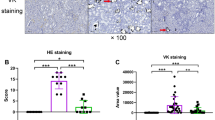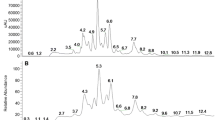Abstract
Introduction
Sanjin Paishi Decoction (SJPSD) has positive effects on stone prevention; however, there is a lack of convincing evidence in the prevention of calcium oxalate stones. This study aimed investigates the effect of SJPSD on calcium oxalate stones and to explore its mechanism.
Methods
The rat model of calcium oxalate stones was established and rats were treated with different doses of SJPSD. The pathological damage of kidney tissues was observed by HE staining, the deposition of calcium oxalate crystals in kidney tissues was examined by Von Kossa staining, and the levels of creatinine (CREA), urea (UREA), calcium (Ca), phosphorus (P), and magnesium (Mg) in serum were analyzed biochemically, the levels of IL-1β, IL-6, and TNF-α in serum were measured by ELISA, and the protein expression of Raf1, MEK1, p-MEK1, ERK1/2, p-ERK1/2, and Cleaved caspase-3 in kidney tissues was analyzed by Western blot. Moreover, the changes in gut microbiota were analyzed by 16S rRNA sequencing.
Results
SJPSD attenuated the pathological damage of renal tissues, reduced the levels of CREA, UREA, Ca, P, and Mg, and inhibited the expression of Raf1, p-MEK1, p-ERK1/2, and Cleaved caspase-3 in renal tissues (P < 0.05). SJPSD treatment affected the composition of intestinal microbiota in rats with calcium oxalate stones.
Conclusion
The mechanism of SJPSD inhibition of calcium oxalate stone injury in rats may be related to the inhibition of the MAPK signaling pathway and regulation of gut microbiota imbalance.




Similar content being viewed by others
Data availability
The datasets used and/or analyzed during the current study are available from the corresponding author upon reasonable request.
References
Yongzhi L, Shi Y, Jia L, Yili L (2018) Risk factors for urinary tract infection in patients with urolithiasis-primary report of a single center cohort. BMC Urol 18(1):45
Skolarikos A (2018) Medical treatment of urinary stones. Curr Opin Urol 28(5):403–407
Huang Y, Zhang YH, Chi ZP, Huang R, Huang H, Liu G et al (2020) The handling of oxalate in the body and the origin of oxalate in calcium oxalate stones. Urol Int 104(3–4):167–176
Haghighatdoost F, Sadeghian R, Clark CCT, Abbasi B (2021) Higher dietary acid load is associated with an increased risk of calcium oxalate kidney stones. J Ren Nutr 31(5):467–474
Li B, Tang Y, Zhou L, Jin X, Liu Y, Li H et al (2022) Association between aortic calcification and the presence of kidney stones: calcium oxalate calculi in focus. Int Urol Nephrol 54(8):1915–1923
Ye QL, Wang DM, Wang X, Zhang ZQ, Tian QX, Feng SY et al (2021) Sirt1 inhibits kidney stones formation by attenuating calcium oxalate-induced cell injury. Chem Biol Interact 347:109605
Ticinesi A, Nouvenne A, Chiussi G, Castaldo G, Guerra A, Meschi T (2020) Calcium oxalate nephrolithiasis and gut microbiota: not just a gut-kidney axis. A nutritional perspective. Nutrients 12(2):548
Liu Y, Jin X, Ma Y, Sun Q, Li H, Wang K (2022) Vinegar reduced renal calcium oxalate stones by regulating acetate metabolism in gut microbiota and crystal adhesion in rats. Int Urol Nephrol 54(10):2485–2495
Yang T, Richards EM, Pepine CJ (2018) The gut microbiota and the brain-gut-kidney axis in hypertension and chronic kidney disease. Nat Rev Nephrol 14(7):442–456
Chi M, Ma K, Wang J, Ding Z, Li Y, Zhu S et al (2021) The immunomodulatory effect of the gut microbiota in kidney disease. J Immunol Res 2021:5516035
Tang R, Jiang Y, Tan A, Ye J, Xian X, Xie Y et al (2018) 16S rRNA gene sequencing reveals altered composition of gut microbiota in individuals with kidney stones. Urolithiasis 46(6):503–514
Chen SJ, Dalanbaatar S, Chen HY, Wang SJ, Lin WY (2022) Astragalus membranaceus extract prevents calcium oxalate crystallization and extends lifespan in a drosophila urolithiasis model. Life (Basel) 12(8):1250
Li MT, Liu LL, Zhou Q, Huang LX, Shi YX, Hou JB et al (2022) Phyllanthus Niruri L. exerts protective effects against the calcium oxalate-induced renal injury via ellgic acid. Front Pharmacol 13:891788
Sun QF, Wang H, Wang XP, Chen BC, Tian LJ, Liu LF et al (2018) Effect of modified Sanjin Paishi Decoction on ureteral calculus in perioperative period. J Hunan Univ Chin Med 38(02):200–203 (Chinese)
Wang Z (2020) Perioperative clinical application of Paishitang III in the treatment of upper ureteral calculi with scorching dampness and heat and stasis under SWL. Hubei University of Chinese Medicine (Chinese)
Luo ZB, Liu CF, Huang GJ, Song JL, Teng XH (2021) Clinical observation of ureteral stones treated with surgery combined with Sanjin Paishi Decoction. J Pract Chin Med 37(05):789–790 (Chinese)
Lu XR (2022) Study on the effect of Sanjin Paishi Decoction combined with extracorporeal shock wave lithotripsy on ureteral stones. Pract Chin Western Med Clin. 22(08):37–39+47 (Chinese)
Qiu J (2020) Reducing the risk of postoperative recurrence of upper urinary calculi based on 16SrRNA sequence analysis. Shanghai Univ Tradit Chin Med (Chinese)
Yu L, Gan X, Bai Y, An R (2021) CREB1 protects against the renal injury in a rat model of kidney stone disease and calcium oxalate monohydrate crystals-induced injury in NRK-52E cells. Toxicol Appl Pharmacol 413:115394
Sancho-Martínez SM, Herrero M (2022) The urinary level of injury biomarkers is not univocally reflective of the extent of toxic renal tubular injury in rats. Int J Mol Sci 23(7):3494
Taguchi K, Okada A, Unno R, Hamamoto S, Yasui T (2021) Macrophage function in calcium oxalate kidney stone formation: a systematic review of literature. Front Immunol 12:673690
Zhang H, Ye HS, Shen Y, He Q (2023) Clinical efficacy of Sanjin Paishi Decoction with holmium laser lithotripsy in the treatment of upper ureteral calculi. Chin J Integr Chin Western Med Surg 29(01):89–91 (Chinese)
Afzal M, Alharbi KS, Alzarea SI, Quazi AM, Ameeduzzafar Z, Patel DM et al (2021) Methanolic extract of Cucumis melo attenuates ethylene glycol-induced nephrolithiasis in Wistar rats. Urolithiasis 49(4):301–308
Wang N, Zhang D, Zhang YT, Xu W, Wang YS, Zhong PP et al (2019) Endothelium corneum gigeriae galli extract inhibits calcium oxalate formation and exerts anti-urolithic effects. J Ethnopharmacol 231:80–89
Tran TVM, Li X, Adams-Huet B, Maalouf NM (2021) Impact of age and renal function on urine chemistry in patients with calcium oxalate kidney stones. Urolithiasis 49(6):495–504
Hong Y, Zhang Z, Ye H, An L, Huang X, Xu Q (2021) Effects of high-sodium diet on lithogenesis in a rat experimental model of calcium oxalate stones. Transl Androl Urol 10(2):636–642
Sharma I, Khan W, Parveen R, Alam MJ, Ahmad I, Ansari MH et al (2017) Antiurolithiasis activity of bioactivity guided fraction of Bergenia ligulata against ethylene glycol induced renal calculi in rat. Biomed Res Int 2017:1969525
Liu Y, Chen S, Liu J, Jin Y, Yu S, An R (2020) Telmisartan inhibits oxalate and calcium oxalate crystal-induced epithelial-mesenchymal transformation via PPAR-γ-AKT/ STAT3/p38 MAPK-Snail pathway. Life Sci 241:117108
Chen ZY, Xiao HW, Dong JL, Li Y, Wang B, Fan SJ et al (2021) Gut microbiota-derived PGF2α fights against radiation-induced lung toxicity through the MAPK/NF-κB pathway. Antioxidants (Basel, Switzerland) 11(1):65
Fang Q, Liu N, Zheng B, Guo F, Zeng X, Huang X et al (2021) Roles of gut microbial metabolites in diabetic kidney disease. Front Endocrinol (Lausanne) 12:636175
He X, Sun J, Liu C, Yu X, Li H, Zhang W et al (2022) Compositional alterations of gut microbiota in patients with diabetic kidney disease and type 2 diabetes mellitus. Diabetes Metab Syndr Obes. 15:755–765
Liu JR, Miao H, Deng DQ, Vaziri ND, Li P, Zhao YY (2021) Gut microbiota-derived tryptophan metabolism mediates renal fibrosis by aryl hydrocarbon receptor signaling activation. Cell Mol Life Sci 78(3):909–922
Su WY, Li Y, Chen X, Li X, Wei H, Liu Z et al (2021) Ginsenoside Rh1 improves type 2 diabetic nephropathy through AMPK/PI3K/Akt-mediated inflammation and apoptosis signaling pathway. Am J Chin Med 49(5):1215–1233
Barr-Beare E, Saxena V, Hilt EE, Thomas-White K, Schober M, Li B et al (2015) The interaction between enterobacteriaceae and calcium oxalate deposits. PLoS ONE 10(10):e0139575
Ticinesi A, Nouvenne A, Meschi T (2019) Gut microbiome and kidney stone disease: not just an Oxalobacter story. Kidney Int 96(1):25–27
Wigner P, Grębowski R, Bijak M (2021) The molecular aspect of nephrolithiasis development. Cells 10(8):1926
Hu Y, Xu J, Sheng Y, Liu J, Li H, Guo M et al (2022) Pleurotus ostreatus ameliorates obesity by modulating the gut microbiota in obese mice induced by high-fat diet. Nutrients 14(9):1868
Funding
The present study was supported by a research project funded by the Hospital of Chengdu University of Traditional Chinese Medicine (grant no. 20ZL08).
Author information
Authors and Affiliations
Contributions
YT, XC and YX conceived and designed the research. YT, JZ, LC and CZ performed most of the experiments and wrote the paper. YT and JZ analyzed the data. All authors contributed to the article and approved the submitted version.
Corresponding authors
Ethics declarations
Conflict of interest
The authors have no conflicts of interest to declare.
Ethical approval
This study was approved by the Animal Ethics Committee of Chengdu University of Traditional Chinese Medicine (20230331005).
Additional information
Publisher's Note
Springer Nature remains neutral with regard to jurisdictional claims in published maps and institutional affiliations.
Rights and permissions
Springer Nature or its licensor (e.g. a society or other partner) holds exclusive rights to this article under a publishing agreement with the author(s) or other rightsholder(s); author self-archiving of the accepted manuscript version of this article is solely governed by the terms of such publishing agreement and applicable law.
About this article
Cite this article
Tian, Y., Zhao, J., Chen, L. et al. Sanjin Paishi Decoction improves the imbalance of gut microbiota and regulates MAPK signaling pathway to inhibit calcium oxalate stones in rats. Int Urol Nephrol 55, 2421–2429 (2023). https://doi.org/10.1007/s11255-023-03641-x
Received:
Accepted:
Published:
Issue Date:
DOI: https://doi.org/10.1007/s11255-023-03641-x




